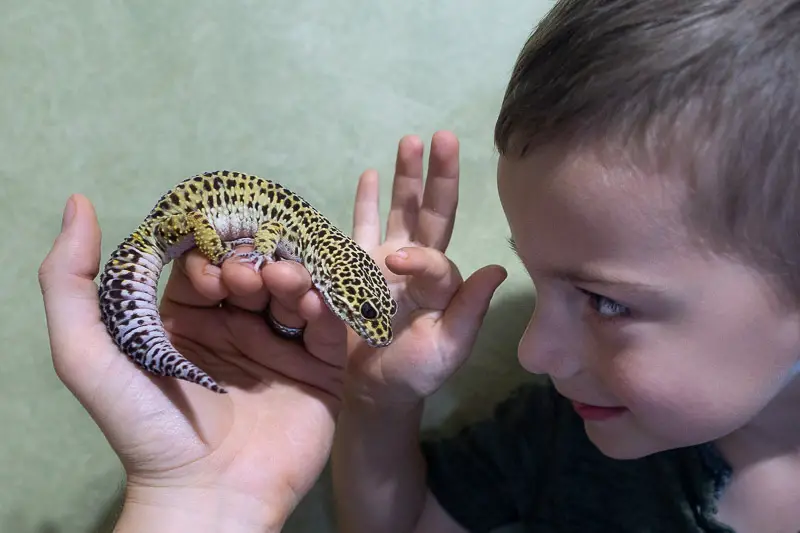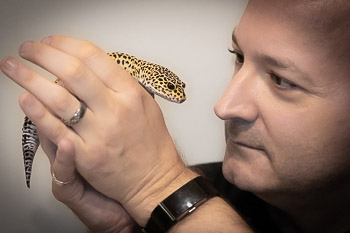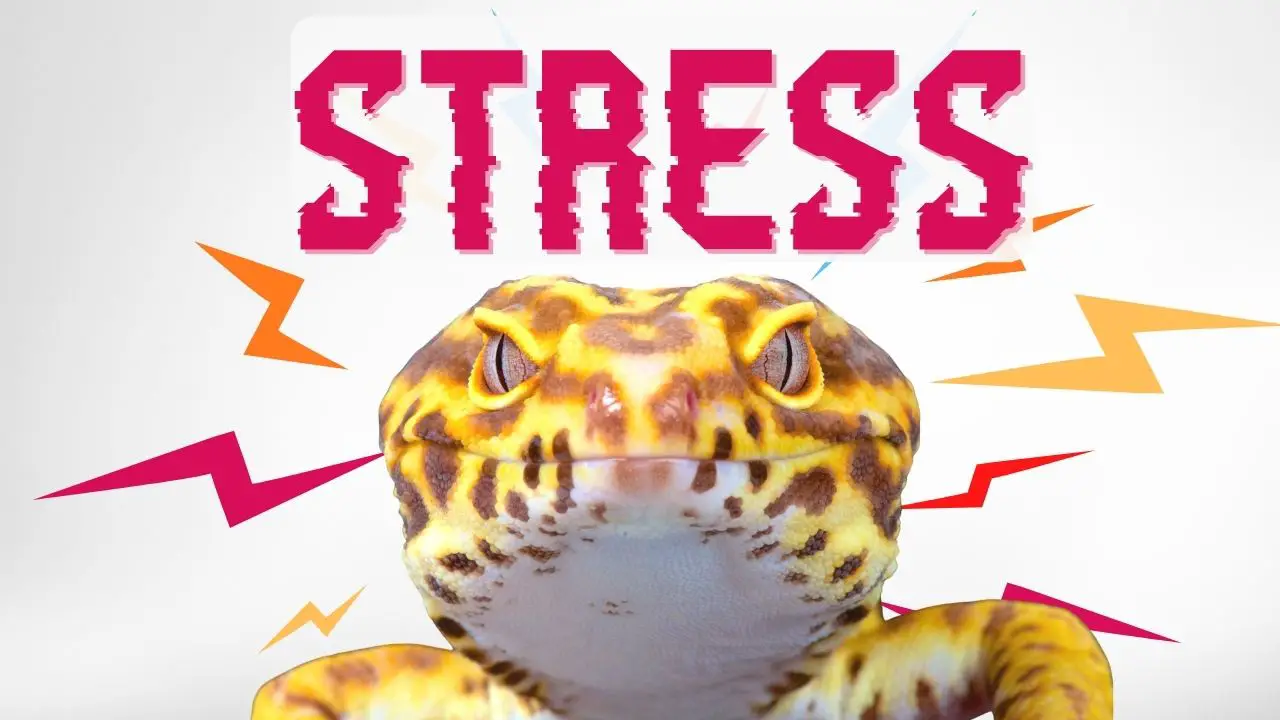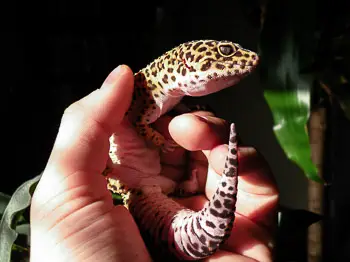Leopard geckos are one of the most common reptiles you’ll find in pet stores, and for good reason: they’re cute, relatively easy to care for, and don’t require too much space. In fact, they’re often sold as “cute pets.”
Pet owners love leopard geckos for their small size, ease of care, friendly nature, and ability to thrive indoors. Leopard geckos are easy to keep and are relatively inexpensive compared to many other types of reptiles. It’s no wonder these pet lizards are they are frequently recommended as a beginner’s choice.
They sound great, but do leopard geckos live up to the hype?
Leopard Geckos Don’t Need much Space
One of the great things about leopard geckos is their size compared to other pets. A full grown adult may be about 10 inches tip to tail. They don’t require a lot of space and can start comfortably in a 10-gallon tank, and transition to a 20 gallon tank once fully grown. This makes them ideal for people living in apartments, condos, or homes without a lot of space.
Because they spend most of their lives on the ground, a larger tank isn’t necessary. In fact, a tank that is wider than it is tall is preferred since it provides more floor space. A 20 Gallon Long sized tank is a good size for a single adult gecko.
Leopard Geckos are Inexpensive
Leopard geckos are one of the most economical reptiles out there. You’ll find them for around $30-60 dollars each depending on where you buy them from.
If you want a fancier or rarer color lizard, you might pay a little more. There are a wide variety of exotic morphs you can choose from that go beyond the spotted yellow and black “normal” leopard gecko. Check out our post on leopard gecko morphs to see some of the variety of colors and patterns available.
Leopard geckos are relatively low maintenance with simple needs. Their housing setup and habitat is simple and doesn’t need much adjusting after your up front cost of a tank and basic setup.
Pet food is always an ongoing expense, and keeping them in feeder insects is fairly inexpensive. You can even breed your own mealworms or superworms to help keep costs down and always make sure you have food on hand.
When it comes down to it, buying a leopard gecko isn’t really that expensive compared to other types of pets. You can check out our post on the cost of a leopard gecko for more information.
Leopard Gecko Longevity
We welcome pets into our lives like they are another family member. The death of a beloved pet can hurt, especially for children. Leopard geckos have longer life spans than your average pet and, with proper care, you can expect your leopard gecko to be with you for many years (or even a few decades.)
The average lifespan of a leopard gecko is around 12 years (a bit less for females, a bit longer for males.) If you buy one today, you could potentially be enjoying its company for 20 years or more.
Captive leopard geckos typically live longer than those found in nature because they receive better care and aren’t subject to predation. For example, they are fed a diet high in protein and calcium, they are kept warm during cold weather, and are safe from predators. Read more in our post on leopard gecko life spans.
Leopard Geckos are Easy to Care for
They are relatively easy to care for. Just remember to provide adequate food, water, heat, and lighting for your pet. If temperatures drop too far, they may become lethargic. Make sure they have enough of room to move around and exercise and you clean their tank on a regular basis.
You can check our post on essential things leopard geckos need to get you and your pet gecko set up with the basics like substrate (reptile carpet is safe and easy), heat source (you need a heat mat), temperature gradient, hiding places, etc. Once you get your tank set up, you’ll need to keep your lizard fed and healthy. Our feeding guide will help you there.
As with most pets, you will need to poop scoop. The good news is, leopard geckos make it easy. They usually select one corner of the enclosure and do their business there (you should plan for this when setting up your tank.) The feces will dehydrate fairly quickly, which makes it easy to scoop out (we usually just use a plastic spoon designated for the purpose.) How often do you need to clean up after them – check our post for the scoop on poop.
What about urine? It’s actually part of the poop, well, kind of. You can read more about it in our post on leopard gecko pee if you’re curious. As a bonus, leopard geckos (or their excrement) don’t have a bad smell.
Related Post: Make sure you have a healthy gecko with our Starter Guide for leopard gecko care
Leopard Geckos are Quiet
Compared to other pets, leopard geckos are small and fairly light they don’t make much noise moving around in their tank.
Leopard geckos do have vocal chords and, while they can make noise, they rarely vocalize, especially once they reach adulthood.
Related Post: Do Leopard Geckos Hiss?
If you live in an apartment or small space leopard geckos are perfect. Even with a 20 gallon size tank, they take up a small footprint and won’t wake the neighbors.
Leopard gecko owners who feed their pets live crickets can attest the crickets will make far more noise than you’ll ever hear from your gecko.
Are Leopard Geckos Dangerous?
They’re quiet, calm, and generally peaceful. They can enjoy being handled and petted, and are often curious about what goes on around them.
While they can get territorial and aggressive to other lizards in their space, they most likely rather run away than have a confrontation. They don’t bite unless provoked, and generally won’t attack without reason.
Leopard geckos are not venomous, and their bites surprise more than they actually hurt. Typically they don’t have the jaw strength to do much damage to a human. You can visit our page on leopard gecko bites for more information.
Leopard Geckos are Good Pets for Kids

Leopard geckos are known for their easy going nature and make a great lizard for beginners. Their docile demeanor also makes them good pets for kids.
Many reptiles and gecko species do not like to be handled. Leopard geckos, once they are used to it, tolerate handling well and can sometimes enjoy it. Caring for a pet can also help teach children responsibility and compassion.
Remember that with any small pet or animal, young children should always have adult supervision. Leopard geckos are small, and can be hurt with rough handling. Although they’re generally pretty calm and docile, they can become aggressive if they feel threatened. To prevent this, provide plenty of hiding places and a secure enclosure, and make sure you know how to handle a leopard gecko.
Wrap up – Do Leopard Geckos Make Good Pets?
Leopard geckos are small, easy to care for, and relatively inexpensive. They require little space, and are friendly and tolerant reptiles. They are quiet, low maintenance, and are inexpensive to buy and maintain. They’re great for kids, too, because they’ll keep you entertained for hours.
The leopard gecko is one of the most popular reptiles kept as a pet. These small, colorful lizards are generally well-behaved, friendly creatures, who can enjoy human interaction and are easily handled. With proper care, your pet leopard gecko will make a great companion for many years to come.
It’s easy to understand why the leopard gecko is often recommended as an excellent choice for a beginner reptile and growing in popularity.





